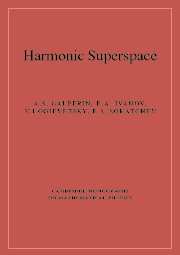Book contents
- Frontmatter
- Contents
- Preface
- 1 Introductory overview
- 2 Elements of supersymmetry
- 3 Superspace
- 4 Harmonic analysis
- 5 N = 2 matter with infinite sets of auxiliary fields
- 6 N = 2 matter multiplets with a finite number of auxiliary fields. N = 2 duality transformations
- 7 Supersymmetric Yang–Mills theories
- 8 Harmonic supergraphs
- 9 Conformal invariance in N = 2 harmonic superspace
- 10 Supergravity
- 11 Hyper-Kähler geometry in harmonic space
- 12 N = 3 supersymmetric Yang–Mills theory
- 13 Conclusions
- Appendix: Notations, conventions and useful formulas
- References
- Index
5 - N = 2 matter with infinite sets of auxiliary fields
Published online by Cambridge University Press: 24 August 2009
- Frontmatter
- Contents
- Preface
- 1 Introductory overview
- 2 Elements of supersymmetry
- 3 Superspace
- 4 Harmonic analysis
- 5 N = 2 matter with infinite sets of auxiliary fields
- 6 N = 2 matter multiplets with a finite number of auxiliary fields. N = 2 duality transformations
- 7 Supersymmetric Yang–Mills theories
- 8 Harmonic supergraphs
- 9 Conformal invariance in N = 2 harmonic superspace
- 10 Supergravity
- 11 Hyper-Kähler geometry in harmonic space
- 12 N = 3 supersymmetric Yang–Mills theory
- 13 Conclusions
- Appendix: Notations, conventions and useful formulas
- References
- Index
Summary
A consistent description of matter supermultiplets (those containing only spins 0 and 1/2 on shell) is a necessary ingredient of any approach to supersymmetry. In the harmonic superspace one can introduce two unconstrained forms of the off shell N = 2 matter supermultiplets, q+ and ω hypermultiplets. They are related by an off-shell duality transformation. On shell they only differ in the SU (2) assignment of the physical fields. Their description in terms of unconstrained analytic superfields (containing infinitely many auxiliary fields) allows one to write down the most general self-couplings. The associated sigma models have complex hyper-Kähler manifolds as their target manifolds. The corresponding analytic superfield Lagrangian plays the rôle of a hyper-Kähler potential, the basic unconstrained object of hyper-Kähler geometry. A simple example of a potential leading to the Taub–NUT metric is presented in detail.
Introduction
N = 1 matter
In the N = 1 case the basic matter multiplet (two spins 0 and one spin 1/2 on shell) is described by a complex unconstrained superfield defined in the N = 1 chiral superspace:
Here ɸ (xL), ψα (xL) are the physical fields whereas F (xL) is an auxiliary field. The most general action for N = 1 rigid matter which yields second-order field equations for the bosons and first-order ones for the fermions has the following
form>
Here K is a real and P a holomorphic arbitrary function.
- Type
- Chapter
- Information
- Harmonic Superspace , pp. 74 - 106Publisher: Cambridge University PressPrint publication year: 2001



